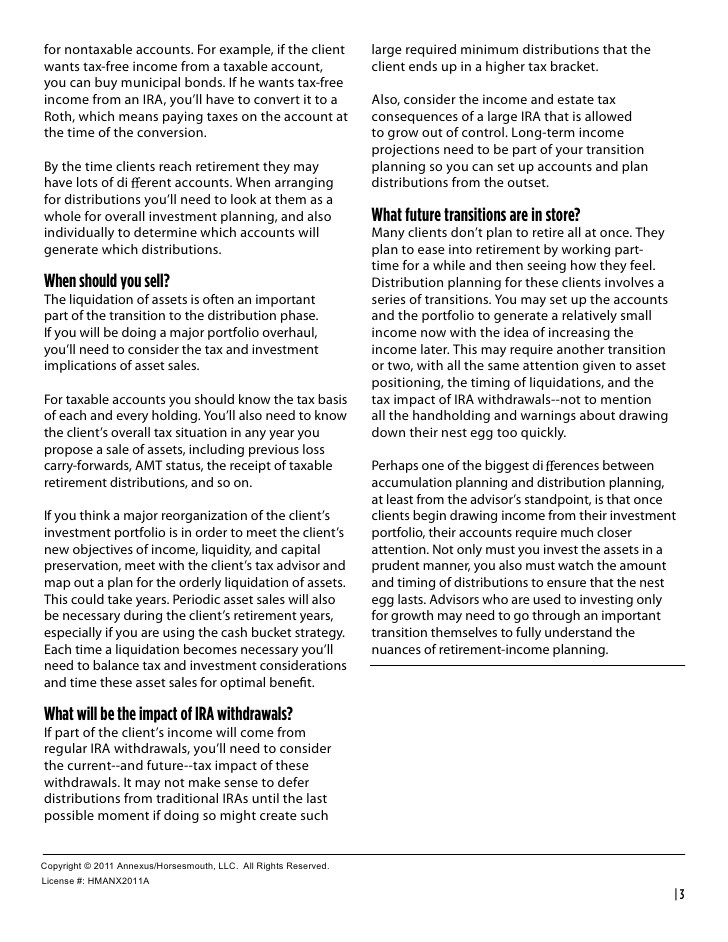Cracking the Nest Egg
Post on: 30 Июль, 2015 No Comment

Cracking the Nest Egg
Which Accounts to Tap First?
When you leave the workforce and begin to rely on your savings for income, you are liberated from many on-the-job tasks: 8am meetings, unfinished documents and strings of emails all go out the window. Yet you are left with one major responsibility: paying yourself. The road to becoming your own HR department – the transition from retirement savings to retirement distribution – requires a major attitude adjustment. You’ve built your nest egg over a successful career; here are some strategies to consider when the time comes to crack it open.
The plan behind retirement savings is simple: you are trying to grow your nest egg as large as possible. Success is measured by the size of your portfolio at retirement and much less so on how that growth is achieved. When it comes time to start withdrawing funds, it’s a different story. Success is measured by your overall happiness, standard of living and trust that your money is not in danger of running out.
First, know that all those tenants of savings you relied on when growing your portfolio, work against you in retirement. Dollar cost averaging and compound interest both work in reverse. Dollar cost averaging – investing a fixed amount each period over time – can help during volatile markets because it helps you buy more when markets are down. But when regularly withdrawing funds, temporary dips in the market can do damage because more shares must be sold to provide an equal amount of cash. With compound interest, friend to all investors, you know that early investment provides a larger base to grow and compound returns. But in reverse, early withdrawal – i.e. a large lump taken from the retirement portfolio early on – will diminish the positive impact of compounding on remaining assets.
Knowing these retirement challenges lie ahead, the next step is to set up a withdrawal plan. A great first step is often to create a cash bucket of safe, liquid investments that can support near term expenses. If you know what your next six months of expenses are, it will make it much easier to tolerate volatility and stick to your long term plan.
Next, it’s time to create a plan outlining which retirement account to tap first. Should you draw from your taxable accounts first or dip into your IRA’s? A basic goal of tax planning is to put off paying taxes as long as possible – deferring taxes in your IRA lets you keep that money to work in your investments rather than losing a portion to Uncle Sam. Yet there are several scenarios when drawing from your IRAs first might make sense:
Are your IRA’s very large, potentially causing your distributions to bump you into a higher tax bracket? If this is the case, it might make sense to begin spending from your IRA’s before you reach age 70-1/2, the year you are required to begin making distributions. Remember that your required minimum distribution (RMDs) are considered taxable income. If your IRA had grown to $2 million by age 70-1/2, your first distribution would be approximately $73,000, potentially bumping you into a higher bracket and forcing you to pay more tax. Had you been spending down the IRA during the first years of retirement, the RMD (and subsequent tax payment) would be smaller.
Investments also matter when deciding how to fund your retirement. If you have stock with large gains, you may want to hold off selling for as long as possible. If these securities become part of your estate, your heirs receive a step-up in basis at inheritance, meaning no capital gains tax is paid on the appreciation earned over your lifetime.
Last, save your Roth for well… last. The strategy for reducing IRA values (and RMDs) doesn’t apply to Roth’s as there is no distribution requirement. Since you won’t have to pay tax on your Roth money, keep it growing tax free, perhaps even into the next generations as a “stretch IRA .”
For more information about investing, financial planning and securing the retirement (for yourself) and the legacy (for your family) that you deserve, please contact us today at 312.669.1650 or use our “Let’s Talk” tool on the right-hand sidebar.














